From 5,000 miles away, it is difficult to tell what is going on in Stuttgart, Germany, where tens of thousands of people have taken to the streets in protest against a $6 billion plan to replace the city’s World War I-vintage train station. Is the main concern the cost? The loss of a historic structure? Or the city’s plan to locate a “true pedestrian haven” on the site of tracks that will be moved underground?

It is probably all of these. One anonymous protester calls the project “a grave for taxes,” and many argue that the money would be better spent on other activities. It was originally supposed to cost about $3 billion, but the price tag is now double that, and this doesn’t even count another $3 billion for a new “high-speed” rail line to the airport.
But what really seems to bother people, they say, is that the plan was made without a serious effort to get public input. Officials claim, of course, that they gave members of the public plenty of opportunities to comment on the plan. No doubt they held some charrettes (or charades as they should be more accurately described). But members of the public–who one writer describes as “the squarest, most conservative, most bourgeois bunch of people”–complain that the officials who approved the plan act with “arrogance” when people object.
Cytoprotective effect of the fruits of viagra uk Prices Lycium chinense Miller against oxidative stress-induced hepatotoxicity. High blood pressure is a common cause as is prostate cancer for instance. use this link discount cialis india To make the journey of learning driving lessons effortless, you have to take levitra india the drivers ed Texas. This expands cgmp inside pneumonic vascular sildenafil super active smooth muscle cells, bringing about unwinding.

“Politicians count on votes so much they hardly get around to listening to voters.”
Flickr photo by MGrenner57.
How often do we hear this in the United States: that a plan was written for our own good and we have to accept it? A writer in the Financial Times (subscription required) compares this with Nancy Pelosi’s statement that Congress had to pass the health care bill “so you can see what’s in it.” But in Portland, you only have to look at all the neighborhoods that were “densified” over residents’ protests to meet planning targets.
Supposedly, residents of Stuttgart will benefit from better access to high-speed trains and urban transit. But how many will use these trains? Not many, considering that (according to the European Union’s latest Panorama of Transport) the average resident of Germany rode high-speed trains only about 160 miles and urban rail transit less than 120 miles in 2006. At least some of us can see why they might question the supposed benefits when the costs are so obviously high.








Randal – when you say “densified,” do you mean upzoned in the traditional way, where property owners can either choose to maintain current density or develop further? What sort of coersion is going on here, or do you believe that people should be able to limit the property rights of their neighbors?
– Stephen Smith
ratliate,
The densification if coerced, through dozens of methods, by government. If there was more freedom to build (much private land is not allowed to build), more people would have houses & larger yards.
There are some times when upzoning is not allowed on account of lower density in hood already there.
What you just wrote about bad planning could also be said of peole like Robert Moses.
“How often do we hear this in the United States: that a plan was written for our own good and we have to accept it?”
Only occasionally, always stated in an exaggerated manner by antiplanners (side note: How many plans simply sit on the shelf because of the lack of acceptance of the plans by the public and politicians? Answer: a lot.).
How often do we hear fear mongering antiplanners twist planners (and politicians) words around to make them look like the Gargomel to their free-market smurftopia?
Stephen Smith,
In Portland, neighborhoods were densified by rezoning to higher densities using minimum-density zoning codes. If someone had a vacant lot, they could only build to the higher density, even if everything around them was lower in density. In some cases, if a house burned down, the owners could only rebuild to the higher density. Cities as small as Missoula have used similar mandatory density codes.
I don’t know anything about the train station, but Stuttgart’s airport has one of the best local adaptations in its design that I have seen. Perhaps the planners developed it, or maybe it was just the architects.
Stuttgart is near the fabled Black Forest, and in the airport the support beams are made to look like trees. Very impressive, and probably not too expensive.
http://travel.webshots.com/photo/1262664157047024099osKJJf
For a time I worked a little north of Stuttgart at a small airfield. Lovely country.
And Randal’s silly implication that people don’t want a “pedestrian haven” is comical. There is a pedestrian zone in 99.9975% of large European cities, 99.4475% of medium Euro cities, 98.375% of small Euro cities…and so on. Harrumphing about transit in a place where you do not live is hard to do, and even harder to do when such places are actually working hard to reduce combustion emissions and implementing measures on the ground. As is evidenced by the increase in rail transport (Randal needs to reread the report – 4.2.4.).
DS
But members of the public–who one writer describes as “the squarest, most conservative, most bourgeois bunch of peopleâ€
And make no mistake about it, this project will not be square, conservative or bourgeois. Those poor Philistines, they just don’t have any vision.
Dan wrote:
> And Randal’s silly implication that people
> don’t want a “pedestrian haven†is comical.
> There is a pedestrian zone in 99.9975% of
> large European cities, 99.4475% of medium
> Euro cities, 98.375% of small Euro
> cities…and so on.
Does that mean that 0.000025% of those large European cities are “pedestrian zones?”
In most European urban areas that I have seen, those “pedestrian zones” are either in neighborhoods that date back to medieval times (like Visby on the island of Gotland,
Sweden), or, perhaps more commonly, 1960’s and 1970’s high-density planning disasters like Rinkeby (suburban Stockholm) or Aylesbury Estate (S.E. London).
If you travel through Europe, you will see these pedestrian zones in the middle of the towns, that date back to the Middle Ages. They are impressive. They also probably couldn’t accommodate automobiles anyway, but clearly the population wanted to retain them.
If you travel in the US, you will see downtowns that are two lane streets with lots of parking. Very pedestrian friendly. Lots of interesting stores.
The average person in the US and Europe do not shop in the above areas. Those are for tourists. The residents shop in the big mall and box stores.
In 10 or 20 years that might change. Then again, it might not. If you know the future, invest in it and make a lot of money. If you want to take tax money and fight the future, then don’t take tax money.
Does that mean that 0.000025% of those large European cities are “pedestrian zones?â€
Reread the passage.
Thanks!!!
DS
Poor babies (the planners)! The people just don’t want to go along with their “plans”. Don’t they understand that these plans were made by their betters, with their sophisticated planning language, their expensive studies, and their superior intelligence?
Borealis said: The average person in the US and Europe do not shop in the above areas. Those are for tourists. The residents shop in the big mall and box stores.
THWM: Though I’ve gotten off trains and walked a 100 feet into malls & big box stores in CBD’s too.
Borealis: In 10 or 20 years that might change. Then again, it might not. If you know the future, invest in it and make a lot of money. If you want to take tax money and fight the future, then don’t take tax money.
THMW: Indeed, I’m already fighting for a better a future.